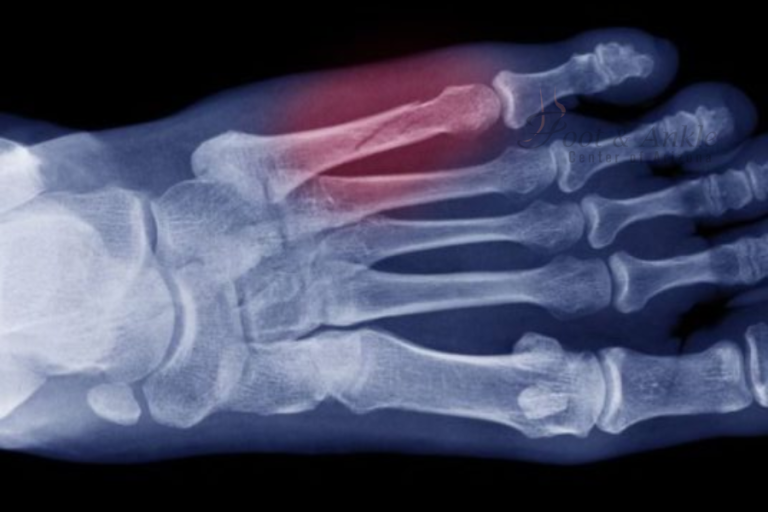A metatarsal fracture is probably one of the most common injuries that is treated within the bones sitting in the middle part of your foot. Because these are long bones and are involved in weight-bearing and motion, metatarsals can suffer fractures. Whether you’re an athlete, runner, or a person who likes casual walks/walkers, it’s important to know about metatarsal fractures for maintaining health in your foot and your general mobility.
What is Metatarsal Fracture?
Metatarsal fractures are caused by different factors, including trauma, overuse, or stress. They are classified based on their location in the bone and the type of break that causes the fracture. One of the primary types of metatarsal fractures is the 2nd metatarsal fracture. This type of fracture is generally caused by repetitive stress or by direct impact.
Types of Metatarsal Fractures
Stress Fractures: They are small cracks in the bone, mainly caused by repetitive force or overuse. They are mostly seen in people who participate in sporting activities.
Traumatic Fractures: These occur because of sudden impact or injury, for example, by dropping a heavy object onto the foot or by direct blow during participation in sports.
Avulsion Fractures: These are associated with the pulling off of a small piece of bone by a tendon or ligament.
Symptoms of Metatarsal Fractures
Commonly reported symptoms in this condition include:
- Pain and tenderness in the affected area
- Swelling and bruising
- Difficulty walking or bearing weight on the foot
- Visible deformity in severe cases
Diagnosis of Metatarsal Fracture
Diagnosis is by physical examination and imaging studies. X-rays usually suffice, but occasionally an MRI or CT scan will be ordered to assess fully the extent of the fracture.
Treatment Options for Metatarsal Fractures
Treatment depends on the type and severity of the fracture. The common treatments are:
Rest and Ice: In the case of small stress fractures, resting the foot and application of ice will help reduce swelling and pain.
Metatarsal Fracture Splint: A splint or even a cast can be used to fully immobilize the foot, giving it time to heal the bone. A metatarsal splint is necessary to hold the bone in the correct position as it heals.
Orthotics: These help shift the weight away from the fracture line thereby putting less stress on the bone.
Physical Therapy: If the bone heals well, rehabilitation exercises can be done to regain strength and flexibility.
TREATMENT FOR SECOND METATARSAL FRACTURE
Mostly the 2nd metatarsal fractures are managed with great care because of the major role in maintaining the foot’s stability. Treatment includes:
Immobilization: Either a boot or cast is worn to keep the foot stable.
Weight-bearing restrictions: Limiting weight bearing on the injured foot side so as not to worsen the injury.
In some severe cases, surgery may be essential to reline and maintain the bone stability
Metatarsal Fracture Surgical Treatments
Surgery is often indicated as the bone Injury is very severe, displaced, or the process of healing isn’t up to the standard with conservative care. Common surgical options include:
Open Reduction and Internal Fixation ORIF: This is the procedure of re-aligning of the bone pieces, followed by stabilization with the help of hardware like screws, plates, or pins. The procedure codes for open reduction and internal fixation of metatarsal fracture CPT.
Metatarsal Surgery with Pins: Here, the fragments are mainly held in place with the help of pins. It is less invasive than full ORIF but still works fine for certain kinds of fractures.
Post-Surgical Care
As it is equally important, good post-surgical care contributes significantly to a comfortable recovery. These include:
Immobilization: Keeping the foot in a cast or boot to immobilize the foot.
Pain Management: By resorting to medicinal relief for pain and inflammation alleviation.
Rehabilitation: Gradual re-introduction of weight-bearing activities; physical therapy to regain strength and flexibility
CPT Codes of the Metatarsal Fracture Treatments
Knowledge of the CPT or Current Procedural Terminology codes for treatments is quite essential for medical professionals but also for patients to help ensure that proper billing and insurance coverage will be applied. Common CPT codes include:
CPT ORIF Metatarsal Fracture: This code refers to the open reduction internal fixation procedure.
Closed Treatment Metatarsal Fracture CPT: This code would be utilized for non-surgical treatments, that include casting or splinting.
Recovery and Rehabilitation
The healing time from a metatarsal fracture varies depending on the severity of the injury and the type of treatment involved. Some of the major things to know regarding recovery from this injury include:
Follow-Up Appointments: The patient would have to visit their healthcare provider regularly to make sure that the bone is healing properly.
Gradual Return to Activity: The patient would have to return slowly to various activities to avoid re-injury
Physical Therapy: Exercise to build up the strength of the foot and enhance flexibility.
Prevention of Metatarsal Fractures
Metatarsal fractures can be prevented through proper shoes, training techniques, and general care of the foot. Prevention techniques include:
Wear Appropriate Shoes: A well-fitting shoe provides support and cushioning needed for the foot.
Gradually Progress in Activity: A sudden increase in physical activity should not be done to prevent stress fracture.
Strengthening exercises: Regular exercises to build up muscles around the foot offer support and hence reduce the possibility of fracture.
Conclusion
Metatarsal fractures, including the 2nd metatarsal fracture, are typical types of injuries that need proper diagnosis and treatment for the assurance of complete recovery. This could be in the form of conservative treatments like a splint for metatarsal fracture or surgical interventions, such as metatarsal surgery with pins. To achieve this, the effective and timely treatment of these fractures is called for in preserving and maintaining good health and mobility of the foot.
The Foot and Ankle Center of Arizona can diagnose and treat metatarsal fractures. Our experienced team is dedicated to personal care in order for you to recover fast and return back. If one has a metatarsal fracture suspicion or experiences foot pain, then contact +1 480.342.9999 for an appointment.
Keep in mind that proper treatment and care are necessary to recover as quickly and fully as possible. Trust the experts at the Foot and Ankle Center of Arizona to guide you through this period of recovery.





